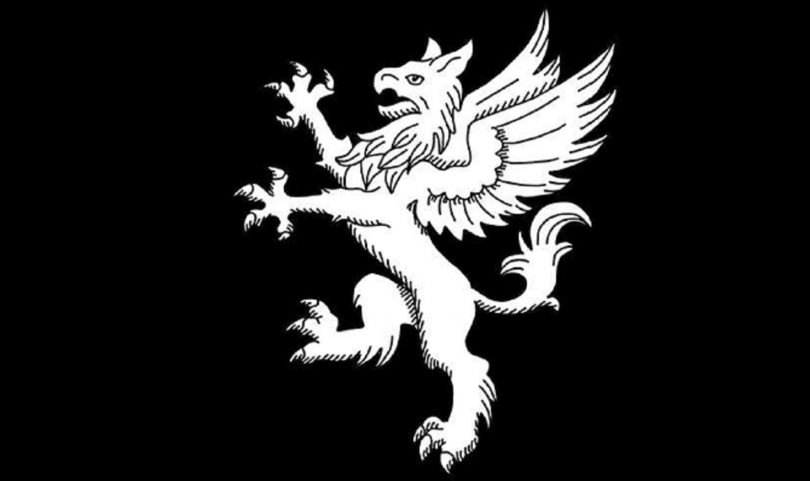Table of Contents
- 1 What Is A Coat Of Arms And What Does It Mean?
- 2 How To Use Coat Of Arms To Establish A Solid Identity
- 3 How To Use Coat Of Arms To Enhance Leadership
- 4 How To Find Or Create Your Coat Of Arms
- 4.1 What is The Best Coat of Arms Design For A CEO?
- 4.2 How Will A Genealogist Help With My Coat of Arms
- 4.3 1. Research And Identify Your Personal Symbols
- 4.4 2. Choose the Best Components
- 4.5 3. Consistent and Coherence
- 4.6 4. Creativity and Originality
- 4.7 5. Communicate And Share
- 4.8 RELATED: Proven Strategies For Aligning Corporate Culture With Family Ethics
- 5 Use your Coat of Arms as Your Identity and Legacy
Coat of arms usage among top-ranking CEOs like Tim Cook and Jeff Bezos, reverberates the impact that symbolism can have on your profession. Of course, a leader’s effectiveness also depends on skills, strategy, and industry. But still, the application of heraldry adds to the personality aspect that’s currently an advantage among C-suite executives.
Certainly, every CEO needs a story that showcases their identity, heritage, and value. They also need to be compelling and succinct in elaborating who they are are, where they come from, and what they stand for. Undeniably, the coat of arms serves that purpose right given the message each component conveys.
The need for C-suite executives to convey in-depth message about their identity is inevitable. For that reason, it is imperative to conduct a thorough genealogy research for rich insights about yourself. A family history research will help you create a perfect symbol and uncover unknown or motivating facts about your heritage.
What Is A Coat Of Arms And What Does It Mean?
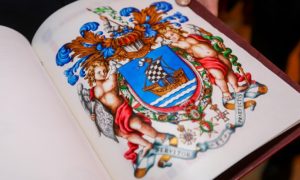
Coat of arms
A coat of arms is a distinctive heraldic design representing a government, organization, family, or individual. Its typical components include a crest, shield, helmet, supporters, and motto.
The heraldry is widely used for identification, and its history dates back to the 12th century. Kings, princes, knights, and major power holders used them to identify themselves in public places, tournaments, and battles.
As the design and heraldry passed down from generation to generation, it became a reflection of family history, legacy, and pride. As a result, bearers started to display it on documents, monuments, estates, and personal items such as clothing and jewelry.
Famous leaders with identity symbols include:
- Napoleon Bonaparte: The French first empire’s coat of arms features a golden eagle and a golden N on a blue background.
- Adams Family: The Adams family produced two US presidents and has arms with “You will preserve freedom, friendship, and faith” as its motto.
- Jefferson Family: The family of the third US president, Thomas Jefferson, also has a coat of arms. The crest is notable for its silver and blue colors to symbolize peace and loyalty.
- Kennedy Family: Former President Kennedy’s family crest features three stars and three helmets representing nobility and courage.
- Donald Trump: The former US president uses a coat of arms for his Scottish golf course featuring three lions and two chevrons.
How To Use Coat Of Arms To Establish A Solid Identity
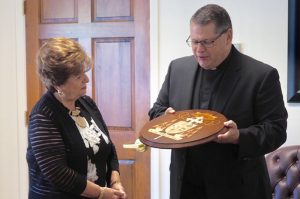
Stickley CEO Aminy Audi presents Bishop elect Douglas J. Lucia with the coat of arms that will grace his cathedra after he was elected as the new bishop of the Diocese of Syracuse, New York.
An existing insignia can help you discover long-lost family connections and learn more about your family history. The symbols, colors, and other components convey a profound meaning to guide future generations on the intended course.
For example, a motto in the insignia can express your family’s beliefs and aspirations. Similarly, a lion may indicate royalty, courage, or connection to a loyal family.
An existing emblem can also help you compare with other families or individuals who share symbols, lineage, identities, or surnames. Such a comparison can help identify commonalities like shared ancestors, relatives, or unknown branches of your family tree. Similarly, a notable difference in the design and components may be the closest indication that you share divergent culture, family history, and identity, with people of a similar surname.
How Much Do You Know About Your Family History, Heritage, And Legacy?
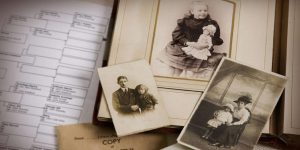
Old photos from your family offer a glimpse of your ancestors, their lifestyle and beliefs.
Embracing your family or personal coat of arms helps you establish a deeper sense of who you are, where you come from, and where you’re headed. Besides, the identity you establish can help in personal growth, healing, and reconciliation.
With the coat of arms comes family history, legacy, and heritage that help discover new aspects of your culture and ancestry. You may also come across long-lost relatives, hidden stories, and unknown meanings depicted on the arms and symbols.
Below are questions to help you develop thoughts that can shape your life and your identity.
- Have you ever researched or seen your emblem?
- What does it mean to you?
- How does it reflect your identity, values, and goals?
- How do you feel about your family’s achievements, challenges, and symbols?
- How do you honor and celebrate your family’s coat of arms?
- How can you use it to inspire yourself and others?
RELATED:
How Personal Narratives Make You An Effective CEO
How To Use Coat Of Arms To Enhance Leadership
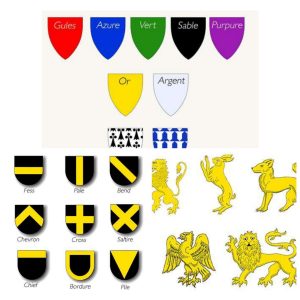
Animal charges , heraldic ordinaries and colors are common components of a coat of arms
Leaders have increasingly embraced the use of coat of arms to express their mission and command respect. Much of this thanks to findings on how a personal and professional brand creates a recognizable and memorable impression, distinguishing CEOs and their companies from competitors.
1. Enhanced Adaptability
Notably, the coat of arms has drastically changed over time to reflect new technology and diverse identity in the modern world. The adaptation is also an expression of what leaders can learn from the use of symbolism. They should remain updated and flexible to changes necessitated by unseen circumstances.
2. Legacy Building
As the ensign thrives for years, leaders too can use their heritage to build a lasting legacy through their decisions and actions. From positively impacting the lives of others to passing their wisdom and skills to the next generations, the ways to build a legacy are countless. Luckily, with a coat of arms, leaders have a stark reminder of their responsibility to continue their legacy and that of their ancestors.
3. Communicating Values and Style
A coat of arms effectively communicates what you stand for, what you aim for, and what you expect from your team. For example, Virgin Group’s founder and executive chairman Richard Branson’s arms has a globe design as the crest to symbolize his global outreach and interest in environmental issues.
4. Corporate Branding with a Personal Touch
Incorporating a coat of arms in the company brings a personal touch into corporate branding, a strategic way to foster a sense of authenticity and difference in the market. Chiefly, personal symbols show the company’s origin, legacy, values, and mission. As a result, the target audience can better connect with the company through the compelling message and memories.
Besides, personal symbols can foster trust as they show the human side of the firm and the leaders’ personality—such transparency bolsters rapport and empathy among stakeholders, establishing a loyal relationship with them.
For example, Harvard University adopted the shield from the family of John Harvard coat of arms to add a personal touch to its corporate branding. The shield remains the institution’s logo and has helped it establish notable influence in education, research, and innovation.
Incorporating the family’s shield into the logo created a powerful brand for Harvard and gave it a competitive edge in the market.
5. Balancing Tradition and Innovation
Coat of arms have been a traditional way to express identity but they have evolved to become an innovative way to communicate. Besides, the emblems are experiencing drastic transformation to reflect modernity while depicting innovative values of their bearers.
Similarly, CEOs can modify strategies or introduce new ones to remain relevant and true to the main objectives.
One way to balance tradition and innovation is to integrate the values reflected on the design in business strategies. Such a balance can help the leader to honor their legacy while building rapport with stakeholders. Also, it lets them embrace growth and change, positively impacting the company, its workforce, and society.
How To Find Or Create Your Coat Of Arms
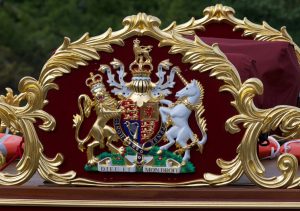
The royal coat of arms, seen here on the Queen’s rowbarge Gloriana, is one of the most famous examples of heraldry in the world.
The only way for a CEO, CFO, CIO, COO, or any other executive to establish their suitable coat of arms is through their identity, values, and history. Surely, studying your roots, family history, heritage, and legacy would be best to know the elements that best reflect your unique heritage and legacy.
Establishing if your family or ancestors had a symbol is also imperative. The search may include a few inquiries to your relatives or searching for clues online. Additionally, finding a symbol is a profound way to connect with your heritage and learn new aspects about your ancestors.
Check for any room for improvement in your discovered arms guided by your circumstances and intentions. Whatever the case, an updated symbol will help you or your family stand out and leave a unique impression.
Besides, the final coat of arms you decide to use can serve as a major inspiration to your team and also help communicate your goals, heritage, values, and mission symbolically.
What is The Best Coat of Arms Design For A CEO?
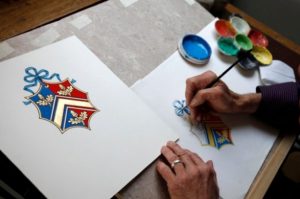
A herald painter sketching the coat of arms
The best coat of arms design should reflect your heritage and communicate your values and legacy. But to know the best values for your leadership style and career, you need professional intervention.
The first step to finding the most suitable shield is conducting in-depth family history research. Luckily, you won’t have to do this yourself as we have expert genealogists to trace your ancestry, structure your family tree, and provide backup records and forensic evidence.
Genealogists have exclusive access to resources, networks, and historical records that can expedite your process to find or create coat of arms. A genealogist can also help you identify the crucial components and designs to incorporate into your insignia, following the rules of heraldry.
Hire a genealogist at RecordClick to help you discover your family history and create a coat of arms that reflects your unique legacy and identity.
How Will A Genealogist Help With My Coat of Arms

Professional expertise saves time, energy, and money
In addition to providing a comprehensive report about your family and the struggles your ancestors endured, professional genealogists will help fine-tune the coat of arms to be a masterpiece of symbolism and legacy. Here’s how:
1. Research And Identify Your Personal Symbols
With the vast resources and access to libraries and archives, genealogists can trace your ancestors and study their lives. Besides, professional genealogists work closely with professional heralds who would make it easy to identify the use symbols in your family.
2. Choose the Best Components
Once your family history research is intact, you can formulate your vision, mission, and philosophy based on your lessons. You want to use the right colors and symbols to reflect your identity and the leadership style and values you want to convey.
A professional genealogist will recommend the best coat of arms shapes, animals, objects, plants, etc., to reflect your identity and values. For example, a lion may depict courage, a star, vision, and red, power.
3. Consistent and Coherence
A coat of arms falls under the customs and rules of heraldry. Luckily, genealogists team up with heralds to ensure your symbols follow the customs of heraldry in matters of components and design. This includes avoiding the use of offensive, conflicting, or copyrighted elements.
4. Creativity and Originality
If you discover a coat of arms in your family, a professional genealogist can help you incorporate imagination and innovation to suit your purposes and preferences. After understanding your family history, adding or changing elements will make the emblem more recognizable and distinct.
Besides finding or creating your coat of arms, a professional genealogist will help you internalize the meaning and significance it embodies. You need to understand what your emblem stands for and how it should inspire your profession and stakeholders. Most importantly, it should stand out on social media or on a logo.
RELATED:
Proven Strategies For Aligning Corporate Culture With Family Ethics
Use your Coat of Arms as Your Identity and Legacy
Using the coat of arms is rewarding and enlightening, especially for corporate leaders. A symbol that links you to your identity, heritage, and legacy significantly differentiates your profession and leadership style. Moreover, the ancestry research that helps create the masterpiece helps you better understand your purpose and belonging.
Besides symbolizing your values and legacy, it reminds you of the honor and responsibility that come with leadership.
Embark on a journey to reflect on your family history and consider how it shapes your leadership. The findings may be surprising, motivating, and enriching to your personal and professional life.
Record Click genealogists will help you uncover your family heritage and create the most suitable coat of arms.
Having a professional handle that part will save you precious time and avoid common mistakes in DIY research and design.
Contact us today, and let us help you discover the hidden treasures of your past and present.

